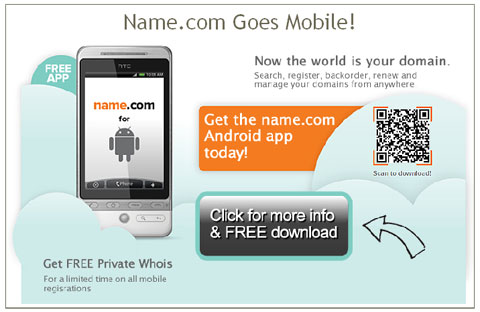Paying People And The NFL Lockout
For the past 18 years, I have been a season ticket holder of the National Football League’s (NFL) New England Patriots. Pictured below is my seats at Gillette Stadium in Foxboro, MA, the home of the Patriots.
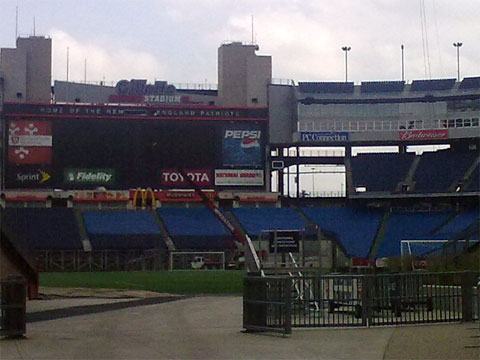
This photo was taken in the summer when there was nothing going on at the stadium, which explains why I am not sitting in them. By this September, I am hoping my seats and all the seats around it will be full on any given Sunday, with fans cheering on the Patriots.
As it stands right now, if things continue as they are, that won’t happen. The collective bargaining agreement between the NFL and the NFL Players Association (NFLPA) expired, and negotiations on a new agreement fell apart. As a result, the NFLPA “uncertified” itself and is no longer representing the players. This same action happened back in 1987, the last time there was a gap in football due to labor negotiations.
Everybody Needs Everybody Else, But At What Cost?
It’s hard for a common fan like myself, or probably most people who are not star athletes or team owners, to quite understand the breakdown in negotiating a new labor agreement. Some have called it the billionaires (the owners) versus the millionaires (the players) and that’s not far from the truth. Issues of salary, plus extending the season to 18 games from 16 and long-term healthcare for retired players are some of the main issues to be resolved.
Where at that scale it doesn’t resonate with me, it does on a much smaller scale, namely within my own business. As part of my Web consulting business Dunkirk Systems, LLC I work with subcontractors, work as a subcontractor to other firms and as well pay myself. When determining project costs and what people I can afford to have on a project or how much I can work for on another, a dollar value has to be determined. Sometimes there is a long negotiation, other times it’s straightforward. In the end, it should be a win-win, otherwise it’s something stuck in the back of my head throughout the project.
Everybody Wants The Games Played
Despite all that has happened, all parties involved want an NFL season. As a fan, that goes without saying. Recently, Patriots season ticket holders got an email from Robert and Jonathan Kraft, the owners and leaders of the team. The second to last paragraph gave me hope in football being played later this year:
We know that many Season Ticket Holders are feeling frustrated by our inability to finalize a deal with the players' union. We apologize for any role we played in that. Please know that we are working diligently to assure that NFL operations get back to "normal" as soon as possible.
Robert Kraft and his family bought the Patriots, a bumbling team, in the early 90’s for what was then a record price. Under his leadership, the team has won 3 Super Bowls and has a shining stadium surrounding by a complex including a Renaissance Hotel, a branch of Mass. General Hospital and a Five Guys burger shop. Kraft has a finance background, understands league finances, and was a season ticket holder before he bought the team. With the metamorphosis of the Patriots over the years, I trust his words and know he wants his fellow fans to be watching games along with him this fall.
What do you think – will there be a 2011 NFL season? Your thoughts and opinions are welcome in the comments of this post.
Did you enjoy this? Subscribe to The Hot Iron by RSS/XML feed or Read by Email.
This is from The Hot Iron, a journal on business and technology by Mike Maddaloni, Founder and President of Web consulting firm Dunkirk Systems, LLC.
Business • Strategize • (3) Comments • Permalink
QR Code In Name.com Email Links To Android App Download
In the past I have said QR codes are a way of tying the offline and online worlds. After seeing the use of a QR code I am writing about today, I am changing that statement to this: QR codes are a nexus between mediums.
Name.com is a great domain name registrar I use personally and for my business (note the link is an affiliate link). They have a clean and intuitive user interface that does not bombard you with upselling options at every click! They also provide outstanding and efficient human support whenever I need it. As part of that service, Name.com have recently launched an app for Android mobile devices, allowing you not only to register new domain names, but backorder domains as well as manage your entire account. They announced this with an email message as pictured below.
In it, there is a QR code. It links to a page on their Web site for the app. The email message is consistent in design with the Web page. The options they include on this Web page, including the ability to download it by SMS (texting to us in the US) and email, as well as a QR code taking you directly to the Android Market.
In this case, the QR code was a bridge between digital mediums – email and the Web. Of course if I read this email on my mobile device I wouldn’t be able to scan it, but as I opened it from within my Thunderbird email client, it worked. An argument can be made whether to link directly to the Android Market from the email rather to a landing page which then links to the Market. This is a great scenario for performing A/B or split testing on the email message, which they may have done anyway. Overall I believe this email from Name.com does a decent job of communicating the value behind the QR code.
What do you think of this QR code use? Would you link directly to the Android Market? Have you or would you use a QR code in an email message? You are welcome to share your thoughts and opinions in the comments of this post.
Did you enjoy reading this? You are welcome to subscribe to The Hot Iron by RSS feed or by email.
A Next Frontier In Mobile Is Behind The Corporate Firewall
While I say I cannot predict the future, sometimes things are so glaring to some and not others, by pointing out you are opening eyes for some people. One of them for me is “a” next frontier in the use of mobile technology – to get beyond the corporate firewall and use all of the tools and data like you can do on a full computer. Note I say “a” next frontier, as it is out there, I just don’t know if it’s the “next” or “last” frontier.
Why do I believe this? Over the years I have managed public Web sites, corporate Intranets, Extranets, portals and knowledge management systems. I have seen how these tools, when used effectively, make people productive. I have also seen how when not managed properly they become a huge mess and waste of resources. Typically, there is a mix of these within most organizations, everything from advanced applications, to a PC under someone’s desk hosting a group’s Intranet Web site, to email.
Going Beyond Email
Using your mobile device to work as you would at work is long overdue. Most corporate workers who have a mobile device use it for email. But beyond email, there may be a limited amount of apps or data available to them. Mobile devices have Web browsers, but you may not be able to make a VPN connection within your company’s firewall. Not having this prevents you from accessing what you can do on your work computer, from your desk or away from it.
More and more email is being used to get around this lack of access. Have you ever asked co-workers or your admin to send you files or information you can’t get at? I see this all the time as friends – even my wife – have to do this in order to get what they may need for a conference call they have to make from a remote location. There’s no other way, especially if getting online with your notebook computer is not an option, or you don’t want to lug it (and power cables, etc.) around.
Going Beyond Mindsets and Existing Network Infrastructure
Shortly before his inauguration, there was buzz about how US President Obama wanted to carry a BlackBerry. In the end, he got one. It is not completely known what kind of security is in use with his device, but the bottom-line is it was achievable. My guess is it’s not out of reach for most companies.
Part of the issue with going mobile with your company information is a mindset it is not secure. This is where you need to go beyond your current infrastructure. As tablets and smarter phones hit the market and become more and more commonplace, the demands from staff will require both of these looming issues to be addressed.
Do I Need An App For That?
Once you go beyond the firewall, the fun begins. Some content and applications may already look great on a mobile browser. Some package applications may already have mobile-friendly interfaces, or even apps to access data. I recently saw a development tool for interfacing with CICS screens on an iPad. (If you don’t know what CICS is, its how most applications were developed on mainframe computers that allowed users to enter and query data. As many CICS screens are still alive and kicking today, thus the opportunity for such a tool). Then there’s the content and applications where you’ll need to either build or buy (or both) to access them outside of the office.
Access content and data in multiple formats on multiple platforms is an opportunity to drive innovation in your corporate Intranet and sites. Everything from comprehensive search to centralizing content to reaping value “dead” or unpopular content can be gained from this effort. As you go forward, build into your requirements mobile platform compatibility, whether for your own internal development or for your third-party vendors. Just think about taking an online training course on your mobile device while sitting in the waiting room for jury duty, and you get the power and convenience of extending the workplace to mobile devices.
Keeping Up With Small Businesses
Many small businesses have some of this capability already. Google Apps works well on Android devices. Salesforce.com has apps for many devices. QuickBooks Online has mobile versions of its full Web-based application. All of these are hosted, third-party services, which does not require the infrastructure to go beyond the firewall. As some larger businesses use Salesforce already, they have an advantage with the ability for their users to work on a mobile device.
Big Picture Thinking On Little Devices
Looking back on what I have presented, I covered a lot, and at a high-level, big picture perspective. As anyone who has worked in computer systems knows, the devil is in the details. But keeping in mind a roadmap to where you want to be, from the short-term to as far out as you can realistically plan, literally getting the information into the hands of those who need it will be critical and advantageous for any business. Let alone the opportunity for those who will be involved in making this happen, whether they build mobile hardware, platforms, apps or supporting software.
Do you agree on this future frontier of mobile? Are you looking forward to it? Are you using it today? Please share your thoughts in the comments of this post.
Did you enjoy reading this? You are welcome to subscribe to The Hot Iron by RSS feed or by email.
QR Codes In Grammy Awards Broadcast Chicago Transit Ads
On Sunday, February 13, 2011 the Grammy Awards will be held and broadcast on the CBS network in the US. To promote this, there are ads displayed on the “L” train platforms in Chicago, also known as the Chicago Transit Authority or CTA. Below is a photo of how 3 ad panels are displayed together.
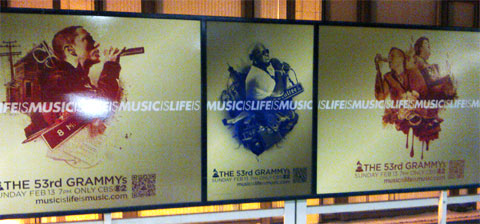
On each panel there is a QR code. When scanned, it goes to a Web site called MusicIsLifeIsMusic.com, specifically to a page for the artist appearing on the particular ad panel. Below is a detailed photo of a QR code for an ad for Katy Perry.
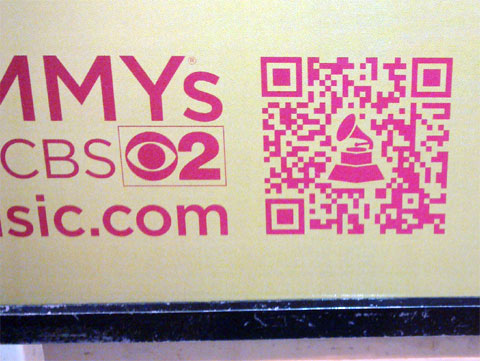
Note I took the second photo before the first one – I first saw the ad panels which featured the second photo at a very narrow point on the platform and was only able to get the detail, where I was able to get a wider shot of 3 panels together, interestingly at the same station and in the 3 panel photo, there is not one of Katy Perry.
There’s a few unique aspects to these ads and how they use QR codes. As each panel has a different QR code, it can be determined which of the 3 was scanned. This can tell one of 2 things – either the person scanning has a preference to the particular artist, or they chose that QR code at random or because it was easier to scan. Also note the Grammy Award trophy in the QR code. As QR codes have built-in redundancy and can have degradation up to 30%, some part of the code can be replaced with another image. There is no magic to this – you have to make the change and test the heck out of it to make it effective.
These particular ads are positioned low to the ground. As a result, you need to bend down to scan, which may cause some not to do so, especially at the narrow part of the train platform where I was. Many times I see QR codes towards the bottom of an ad, which is unfortunate, as QR codes are not afraid of heights!
What do you think of this use of QR codes? Please share your thoughts in the comments of this post.
Did you enjoy reading this? You are welcome to subscribe to The Hot Iron by RSS feed or by email.
QR Code T-Shirt
For my first example of a QR code in action, I chose a medium displaying one which people may not think about – clothing. We have seen QR codes on signs, posters and flyers, but how about t-shirts? In the photo below, that’s me on the right, sporting a QR code t-shirt, and I am with Dennis Bournique at the Nokia E72 Mode beach Party last summer.
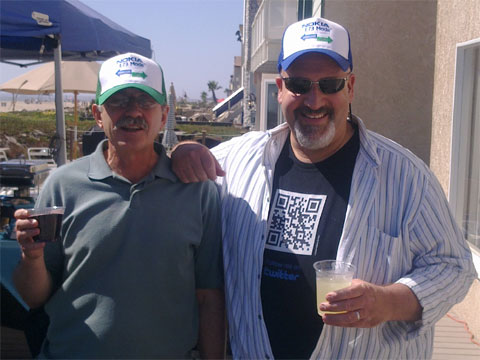
The t-shirt was given to me by QRazystuff.com, a UK-based firm that puts QR codes on apparel. When scanned, this QR code takes you to my Twitter account, @thehotiron.
A QR code on clothing will get people’s attention. On this shirt, it’s a decent size on the front of the t-shirt. Another great place to put one is on the back, as reinforcement for any messaging on the front of the t-shirt. Of course if you are walking around with a QR code on your t-shirt, don’t be surprised if someone stops you to scan it, as that’s how they will be able to scan it.
QR codes on t-shirts and other apparel can be used for promotions or games, where people in a defined area will wear them and scan each other’s as part of the game. They can also be a variation on the traditional brand tag.
Would you wear a QR code on a t-shirt? Are there other reasons for wearing one? Please share your thoughts in the comments.
Did you enjoy reading this? You are welcome to subscribe to The Hot Iron by RSS feed or by email.



